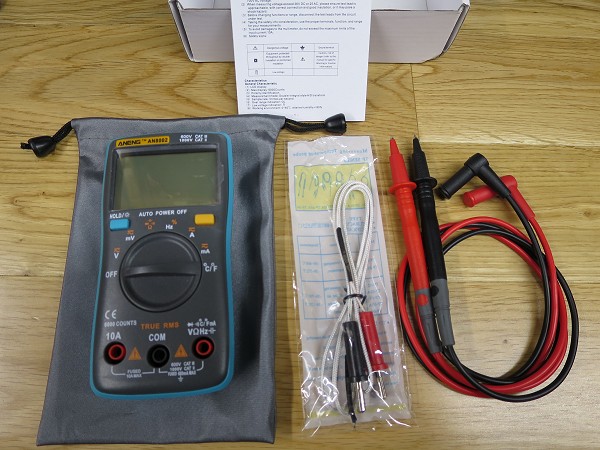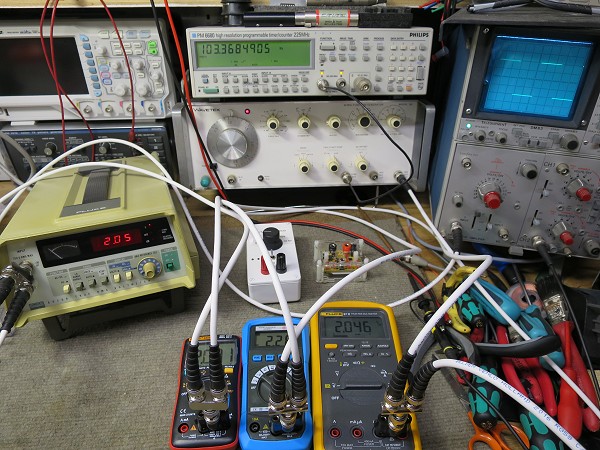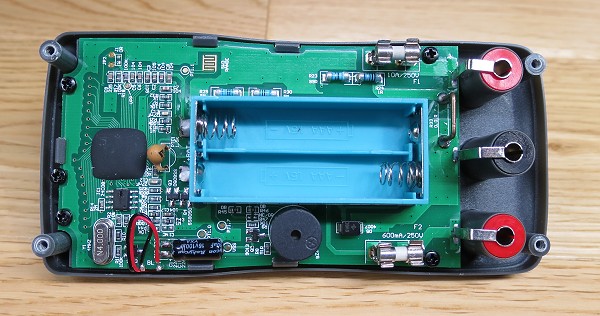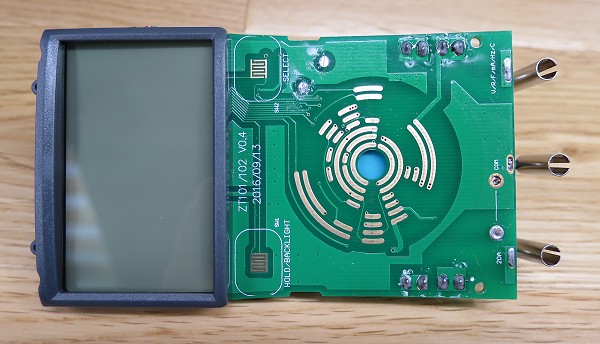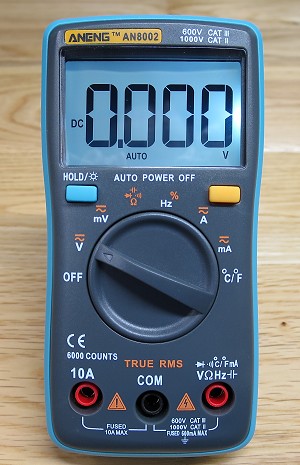 Important: before
reading this review, please read this important safety information.
Important: before
reading this review, please read this important safety information.
Overview
The Aneng AN8002 (aka Zotek ZT102) is a small multimeter that is available for around £12 delivered. Don't be deceived by the size; it packs an astonishing amount of functionality into that cute little case.
First of all, it's true RMS. Let's just pause for a moment and reflect on that... True RMS is a premium function that you ordinarily would have to pay a decent amount of money to get. Here it is on £12 multimeter!
Usually, true-RMS conversion is done with a special IC that is essentially a miniature analogue computer, performing the squaring, averaging and rooting all in the analogue domain. The classic IC is the AD536, which was used in many top-flight multimeters over many decades. But this was (and remains) an expensive part, and the modern-day versions are also relatively pricey - you won't find them in a £12 multimeter!
What's changed is the incorporation of the RMS conversion right inside the chipset. This meter uses the DTM0660, which is a highly integrated solution for multimeter manufacturers. The resulting low component count really is rather impressive.
Next, this is a 6000-count meter. Again, this is astonishing. At this end of the market, it's always been 2000-count at best.
What else? Well, basic DC accuracy is 0.5%, and along with the expected voltage, current and resistance functions, it also measures capacitance, frequency, duty cycle, and temperature. The only things lacking is a µA range and a manual ranging button. It runs from a pair of AAA batteries (not supplied).
The safety rating is 600V CAT III and 1000V CAT II. This seems pretty optimistic to me, and in common with most multimeters reviewed in this section, I would only use this on the bench in low-energy situations.
Unboxing
The unit comes in a plain white box which contains the meter, probes, a standard thermocouple, plus a bonus carry bag! There is a manual, which is written in pretty good English, but the print is very small - and there are several errors in there. The probes are rather small, but the leads are much more flexible than the BSIDE types - I don't mind using them at all. They are rated at a claimed CAT II 600V, or CAT II 1000V with the additional tip covers in place. The current rating is 10A. They are just shy of 80cm.
The meter feels very solid. There is no holster, and the blue case is hard - no soft-touch plastics here. The manufacturer claims it will survive a 2 metre drop-test. On the rear are 4 moulded "bumps" that act as feet, but as these are obviously the same hard plastic, it will slide around a bench unless it's covered with carpet or some other non-slip surface. There is a stand that hinges out from the back, but being rather thin, it bends readily and will also slide around. The mode switch is nice and positive, but rather stiff so you'll need to steady the meter with a spare finger when operating it. Much better than the RS14 though. With every change of position, the meter beeps, somewhat needily.
There are two pushbuttons - nice soft-touch membrane types - for Hold/Backlight and Select.
Operation
It's hard to fault the operation of this meter. The yellow Select button cycles through the modes as indicated on the front panel, and the Hold/Backlight logic has been thought through (unlike the on the RS14!). In other words, if you hold the button, the backlight comes on after 2 seconds, but the state of the hold function is not affected. Sadly, the backlight only stays on for 15 seconds - which seems to be the norm for cheap meters.
The LCD is one of the best I've seen in terms of contrast and viewing angle. It goes a bit dim when you view it at right angles to the display and above, but in use, you're much less likely to do that. When it's lying down on the bench, it's perfect. Even at extremes, there's hardly hint of unlit segments "ghosting", unlike the RS14. The backlight isn't bad, but there is a hotspot on the right of the display where the LED is. But because the contrast is so good, you shouldn't need to use it all that often.
Going around the range switch (options available by pressing Select in brackets):
- V (DC, AC, Hz, duty cycle)
- mV (DC, AC)
- Ω (resistance, continuity, diode test, capacitance)
- Hz (Hz or %)
- A (DC or AC)
- mA (DC or AC)
- Temp (°C or °F)
Being a small meter, the mA socket is shared with Volts, Ohms, etc - as always, be careful with this arrangment. The 10A range has its own socket. There are fuses for each current function.
The best available resolution is 10µV, 10µA, 0.1Ω, 1pF, 1 degree, and 0.001Hz.
It's worth saying that in mV mode, the meter presents a high input impedance (apparently >60MΩ, though I reckon it's more like 20GΩ!) rather than the usual 10MΩ. This means that in the mV mode, the reading will float about if the probes aren't connected to anything. Interestingly, in mV mode, there are 2 ranges - 60mV and 600mV - despite the manual saying that there is only a single 600mV range.
There is a curious feature in mV mode - a deliberate dead spot has been built in, so the meter won't show anything between below ±50µV. It literally goes -00.06mV, -00.05mV, 00.00mV, +00.05mV, +00.06mV. I guess this is to stop people worrying about a meter that doesn't go to 0V when probes are shorted. Outside of the ±50µV range the meter is just fine, so not a problem in practice.
Auto-ranging is not quite as quick as the BSIDE ADM01/02 or RS14 meters, but the quicker settling time - with no overshoot - compensates for this, and overall the meter feels very slick in operation. As mentioned, there is no manual range button, sadly - although there are occasional references to it in the manual! It's a shame the Hold button isn't a range button, as the hold function is virtually pointless in my opinion.
Regarding AC measurements, the bandwidth is a little bit limited, reaching out to just 1kHz according to the spec. The -3dB point is 3kHz. This is a function of the chipset, which incorporates digital filtering ahead of the RMS DSP. From what I've seen of other meters, it seems that a -3dB point of 3kHz is a strong clue that the DTM0660 chipset is being used.
The diode range gives around 3.2V - which is independant of the battery voltage because it's generated by a charge-pump circuit and then regulated inside the IC - so can be used to test LEDs, including blue and white ones. Continuity is latched and is reasonably quite quick to respond, though not as quick as a good Fluke. It works at 40Ω, which is bang-on the spec given.
The frequency function has one problem - it requires the signal to cross 0V. A lot of signals will, so no problem, but if you're looking at TTL logic signals, you won't get a reading. This can be fixed by putting a capacitor in series with the input.
Astonishing, it had no problems going to 80MHz (yes, mega-Hz). Joe Smith's video (see below) suggests it'll go higher, but beyond that frequency the +17dBm (~1.6V) from my RF generator isn't enough for it. Joe doesn't mention the signal level used for his test.
The sensitivity is very good. At low frequencies (<100kHz), it's about 20mV RMS (sine wave). At 1MHz, it's roughly 40mV. At 10MHz, you need just over 1.2V, and at 30MHz, 1.5V. As mentioned, I managed to get to 80MHz with the +17dBm (1.6V) from my RF generator, so it's interesting that the response essentially plateaus after the initial rise between 1 and 10MHz. Unless I've missed it, there's no specification given for sensitivity.
It's worth saying that in frequency count mode, the display goes to 9999 counts, so you can read 9.000Mhz with 1kHz resolution. Also, the capacitance measurements are the same - presumably because measuring capacitance on a DMM usually involves timing how long it takes to charge the capacitor under test. I've just measured a 1µF film capacitor as 994.6nF, for example. Incidentally, it takes about 9 seconds to measure my 3300µF test capacitor. For comparison, my Fluke 87V manages the same in about 3 seconds.
Current consumption from the two AAAs varies between 1.1mA and 1.8mA. Interestingly, switching to an AC mode adds 0.3mA to the consumption - presumably that's a result of enabling the RMS conversion section. Shorting the probes in Ohms takes the consumption up to 2.5mA, and sounding the buzzer in continuity results in 14.4mA in total. The backlight takes just 4mA. Given these numbers, it makes you wonder why (a) the backlight only stays on for 15 seconds, and (b) why the auto power-off is only 15 minutes (press Select while powering up to disable auto power-off, though it'll still beep at you every 15 minutes).
The low-battery indication comes on at 2.43V, and the unit continues to give accurate readings until it switches off at 2.18V. At this point, if you press Select, the unit boots up and then shuts down, showing the battery-low indication for about 2 seconds in the process. Out of interest, I kept reducing the voltage while doing this. Once down at 1.84V the display contrast suddenly got poorer, then it finally gave up at 1.76V. So no excuse for leaving dead batteries in there! If you leave it to power down automatically, the current consumption is only 4.4µA
Is it really true RMS?
At this price, you could be forgiven for questioning this claim. The obvious answer is "why would they lie about something that is very easy to check?". But, for the doubters, I did check it out:
Here we see my trusty Wavetek 162 feeding a host of meters in parallel, along with the 'scope. The Wavetek can generate almost any waveform you need for this sort of test, and the Fluke 8920A is as close to true-RMS as it gets, being that it uses a thermal sensor to do the conversion. The Fluke 87V is included as a more realistic point of reference. There's also a BSIDE ADM02, which uses an average-responding rectifier and gives us the expected errors. So will the Aneng match the Fluke or BSIDE readings?
In short, yes, this is indeed true-RMS. Even with very narrow pulses (hence high crest factor), the Aneng agreed with the 87V at all times. At the narrowest pulse widths, these two deviated slightly from the 8920A readings, but that's because it can cope with higher crest factors, of course.
What doesn't help is a YouTube video which claims that the meter is not true RMS. The mistake there - which the person acknowledges in the comments - was using 1kHz as the test frequency. Remember the low AC bandwidth of this meter - the 3rd harmonic of a 1kHz square wave will be 3dB down, and the 5th, 7th, 9th, etc will be much more attenuated. For that reason, my tests were at 100Hz. In the manual, they state that readings about 200Hz are "for reference only", implying that inaccuracies will result as a result of the bandwidth limit.
Teardown
Start by removing the battery cover and the tilting bail (single screw that fits in a brass insert), then 4 self-tapping screws:
I've seen lots of YouTube reviews of these meters where they struggle to open it up, resorting to poking small screwdrivers in the screw holes, but there really no need once you know the trick: the battery holder stays with the PCB, so all you have to do is push it from the rear. Simple! The case is a reassuringly tight fit, thanks to the decent overlap between the two halves.
The first thing that struck me was the low component count. Then the tiny fuses. At least they're ceramic! They are 10mm types that are normally sold with wires attached to the end caps for soldering into a PCB. Clearly these aren't exactly HRC types!
Not surprisingly at this price, there is hardly any input protection. There is a PTC between the battery holder and the COB, and a pair of transistors acting as a high speed clamp (Q3, Q4), but that's all. The main 10MΩ divider resistor is a pair of 5MΩ 0.25% MELF resistors (R29, R30), and the shunts are R22 and R24, along with R33, of course. There is a single diode which I presume is for protection on the current ranges, but I'd have to remove the battery holder so I could follow the PCB traces to be sure.
Note the EEPROM next to the COB - this stores the calibration constants along with some setup data. This is a mixed blessing - it means there are no pre-set resistors to get knocked and cause drift, but it does mean that recalibration in the future will be much more difficult. But having said that, this chip is appearing in a lot of meters now, and some folk have reverse-engineered the EEPROM data to modify the way their meters behave. I'm hopeful that in the future, someone will produce some tools that will allow us to easily re-calibrate and reconfigure these meters.
Note SW3, labelled "RANGE". This does indeed change range. So why is it hidden away inside the meter like this? The answer comes when you read the DTM0660 data sheet, which briefly describes how the calibration is done using 3 buttons. So if there are only 2 buttons on the front panel, a third will be needed for this, and here it is! It's just a shame this particular button is not on the front panel.
The single electrolytic capacitor is a Rubycon YXA. At this price point, I was surprised to see a name-brand capacitor in there!
The input terminals are the expected pressed type, but unlike those in the BSIDE ADM01/02 meters, these are supported by mouldings in the rear panel so they work better in practice than they might appear, and they don't stress the solder joints in the same way. There is an issue when using standard test probes as the plugs are slightly longer than those supplied with the meter, so don't go all the way in. This doesn't cause a problem, but looks a bit strange. Luckily, as mentioned earlier, the supplied probes are reasonable enough for low-voltage work.
Undo the 5 black self-tapping screws to remove the PCB:
And here's the OEM model number (ZT102). The PCB appears to use gold plating for the function switch and buttons, which is good to see at this price. There's a fair bit of flux residue from the fuse holders and buzzer.
There are no isolation slots or blast shields, but track spacings on the PCB are reasonable. Things are a bit cramped in the area of the function switch, which is to be expected given the small size of the meter.
While on the subject, I must mention Joe Smith's tests on this meter. He subjected this meter to high voltage transients, and this meter survived tests that the Fluke 87V did not. That was rather surprising, but shows that you can only predict so much from appearances. Remember, this meter has no MOVs or similar, and just a single PTC for protection. It survived mains voltages and 2500V transients applied to all functions (apart from current, of course) with no problem. It took 3kV to damage it slightly, and ~6kV to kill the IC. And when it was hit with some seriously high energy afterwards, the case remained intact - which is really what safety is about (personal protection, not necessarily surviving electrically undamaged). When he looked inside, it appears that the energy jumped across the PCB traces that form the range switch - perhaps it would have done even better if it was a larger meter with more generous spacings? Either way, he was very impressed with how well it did.
Conclusions
I said it at the beginning, but I'll say it again: this is a 6000-count meter with true RMS for just £12!
It's clear that this chipset is shaking up this end of the market. It offers extras like frequency/duty cycle and capacitance, along with EEPROM-based calibration that should resist drifting, and will run forever on a pair of AA batteries. I still can't quite believe what you get for the money!
I love the tiny size and massive display. The meter is really convenient for electronics work on the bench, where you can have the meter inside the item you're working on - no having to look away to wherever the large meter might be sat. Even the supplied probes are OK. Better ones can be used, but as mentioned they do sit proud of the case slightly - not a problem in practice.
In terms of functionality, the only things missing are a µA range and a manual ranging function. I don't regard these omissions as serious, as I have several multimeters and pick and choose according to what I'm doing. If you can only afford to buy one, this might matter more.
Obviously, this is for low energy electronics work only, but having said that, this meter performed really well in Joe's tests, so in reality it appears to be more rugged than you might assume.
In short, but with confidence! This meter sets a new standard, and all the 2000-count, non true-RMS meters at this price point suddenly look rather silly. Frankly, I'd pay double this price - and double again if they fitted better terminals, better fuses, and a MOV or two.
Finally, just be aware that there are several similar models in the range that look identical, so be careful when buying - there are versions that are only 2000-count, for example. Often, eBay sellers put 3 or 4 different models on the same listing page, so check the drop-down carefully before buying!

